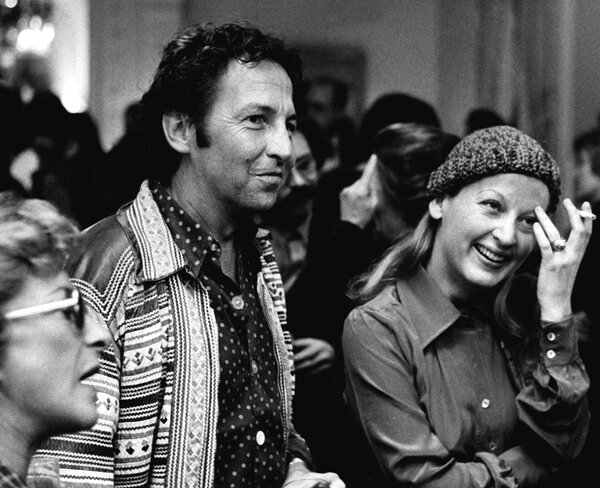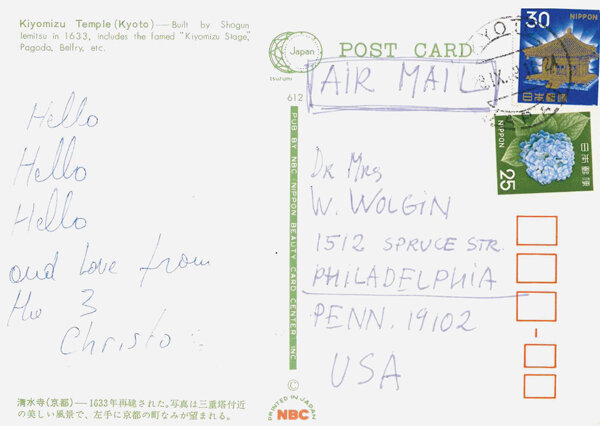232
232
Plastic, base metal
3.50 x 2.25 in
estimate: $100–150
result: $1,008
follow artist


Art is for everybody.
Keith Haring

As consummate patrons of the arts, Acey and Bill Wolgin did not just live with the art that they collected—they lived alongside the artists who made it. Through their generous support of both individual artists as well as institutions they cherished, the Wolgins became widely celebrated collectors known for their friendships with artists—including Andy Warhol, Jasper Johns, Claes Oldenburg, Roy Lichtenstein, Arman, and Robert Rauschenberg—that were sustained, not least, by legendary parties thrown at their Philadelphia apartment.
Bill Wolgin, who practiced as a urologist, met Acey through her brother with whom he attended medical school. The pair married and made strong roots in Philadelphia—indeed, the Wolgins may be credited for having a significant role in elevating the City of Brotherly Love to the cultural destination that it is today. In the 1960s, Acey was a founding member of the Arts Council at the Young Women’s Hebrew Association, which helped spark the city’s contemporary art scene. In 1974, Acey became one of the first women elected to the board of the Philadelphia Art Museum, where she served as a trustee and trustee emeritus for the rest of her life. When Robert Indiana’s LOVE stamp was released at that museum, Acey’s birthday party doubled as the event after-party. Among the attendees was the artist Arman, who absconded with a piece of the LOVE stamp-themed cake in order to seal it in resin.

The Wolgins would later relocate to Boca Raton, where they became actively involved in the Boca Raton Museum of Art and eventually funded the Wolgin Education Center. After returning to Philadelphia, Bill Wolgin would become involved in the Woodmere Art Museum as a trustee, helping to guide the institution’s expansion. Works from the Wolgin Collection are now held in all three of the institutions where they became involved, including Yves Klein’s Portrait Relief I: Arman at the Philadelphia Museum of Art, Fletcher Benton’s Donut with Balls and Half Moon at the Boca Raton Museum of Art, and a group of large-scale sculptures by Sam Maitin at the Woodmere Art Museum.

Surrounded by his parents’ collection from a young age, Richard Wolgin recalls meeting many of the artists whose works he knew intimately—especially memorable was the flaming red hair of Jeanne-Claude when she and Christo dropped in one weekend. (When they weren’t celebrating together, the Wolgins kept correspondences with many of their artist-friends, who sent postcards and, sometimes, drawings.) As kids, Richard and his sister would, naturally, delight in playing with one of Harry Bertoia’s sound sculptures. When Richard was twelve years old, Acey gave him his first work: Roy Lichtenstein’s CRAK!, which he affixed to his bedroom wall with thumb tacks—inadvertently bringing the work back into the realm of mass media and pop cultural detritus that so inspired Lichtenstein.
The works featured in The Acey and Bill Wolgin Collection represent a life lived through, and for, art—“It’s not just buying something to hang on the wall,” says Richard, “it’s a piece of their lives, that are now part of our lives.”
Keith Haring 1958–1990
Keith Haring was born in 1958 in Reading, Pennsylvania. From a young age he enjoyed drawing, especially Disney characters and other cartoons. He initially wanted to become a commercial artist but after a year at the Ivy School of Professional Art in Pittsburgh, Haring dropped, moved to New York City and enrolled in the School of Visual Arts (SVA). Haring immediately felt connected to the thriving alternative arts scene happening downtown in the late 1970s and became friends with Jean-Michel Basquiat and Kenny Scharf.
Inspired by the ideals of “art as life” and moving the art experience out of galleries and into the streets, Haring’s first major works were his subway drawings. Haring produced over one hundred of these public works between 1980 and 1985, integrating his now-iconic exuberant, cartoonish outlined figures into everyday public space in a way that directly engaged its viewers. Haring recalled that the most important aspects of these works was the immediate engagement people had with them, asking him “what does it mean?” and giving him feedback that he’d then incorporate into future drawings. In this way, these works became reflections of the people who viewed them, responsive to and in dialogue with their environment. These works quickly garnered the attention of tastemakers in New York and his first solo exhibition was held at Westbeth Painters Space in 1981 and a celebrated show debuted at the high-profile Tony Shafrazi Gallery in New York the following year.
Throughout the 1980s, Haring was committed to democratizing the art experience and along with paintings, he also created theater sets, billboards, murals, advertising campaigns and even a line of Swatch watches. In 1986 he opened the Pop Shop in SoHo, selling apparel, posters and toys bearing his drawings. This was a controversial move, as many galleries criticized Haring for “de-valuing” the art object while others, such as Andy Warhol, championed Haring’s insistence on making art accessible and affordable. Pop Shop was highly influential to contemporary crossovers of art and merchandise that are now so dominant, as in the work of Jeff Koons, Yayoi Kusama, KAWS, Shepard Fairey and Takashi Murakami.
In addition to this ideology of accessibility, Haring was also very socially engaged and used his striking imagery to promote awareness of various political and social campaigns. His many notable public works included a mural on the western side of the Berlin Wall, the Crack is Wack mural in New York, and a mural for the 100th anniversary of the Statue of Liberty in 1986. Haring was diagnosed with AIDS in 1988 and used his presence in the arts community to raise awareness of the crisis. In 1989, a year before his death, he established the Keith Haring Foundation, whose mission is to raise funds for AIDS organizations and children’s literacy and arts programs.
Since his death in 1990, Haring has become one of the most widely-recognized and celebrated artists of the 20th century, priming the path for the rise of graffiti and street art in the 21st century and a socially-conscious approach to talking about sexuality, intimacy and visibility through public art. Famed New York gallerist Jeffery Deitch asserts that Haring made “works that can hang in museums alongside masterpieces…and hold their own as art-historically important pieces,” expressly because they embrace and engage popular culture with an immediate and dynamic visual language that celebrates the joy and chaos of our society.
Auction Results Keith Haring